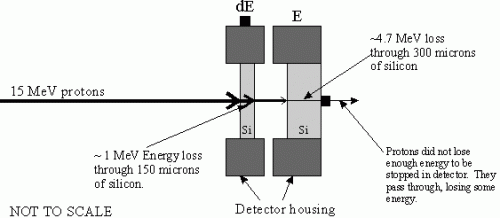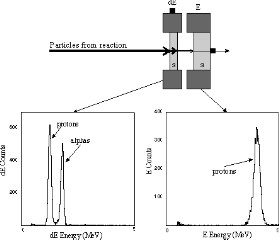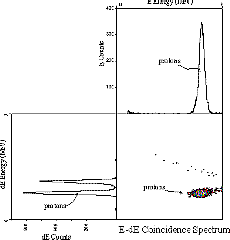The 3He(d,p) Reaction
Brian Fisher, Brian DeMarco, Jenny Sweitzer
Faculty Advisors – Steve Padalino and Kurt Fletcher
Funded in part by The U.S. Department of Energy
A good description of the project is given in this abstract submitted to the March 1996 APS meeting:
The ability to produce high energy protons is requisite for high energy calibrations of charged particle spectrometers used in plasma research. Production of such protons using the 3He(d,p)He4 reaction has been accomplished at State University of New York at Geneseo using helium-3 implanted targets fabricated at Triangle Universities Nuclear Laboratory. The 3He(d,p)He4 reaction protons energies were measured with a silicon surface barrier detector telescope. The telescope, composed of two detectors working in coincidence and set in tandem, measured the protons energy loss as they passed through the first and then the second detector. The protons were uniquely identified by their energy losses through each of the detectors.
How it was Done
How do we get high energy protons?
A nuclear reaction!

The difference in masses between the products (the 4He and 1H) and the reactants (the 2H and the 3He) is converted into roughly 18 MeV of energy. The 4He (also called an alpha particle) and the proton share this energy so that both energy and momentum are conserved.
Each particle exiting the reaction has a specific energy and upon entering a silicon surface barrier detector it deposits all or some of it’s energy. So using energy as a “finger print”, we can identify the peaks in our energy versus counts spectra. A proton traveling at 20% the speed of light (15 MeV) does not stop in the 300 micron thick surface barrier detector because it is too fast. In order to confirm the detection of high energy protons, the amount of energy deposited must first be calculated. sing some Fortran code rom TUNL, we are able to calculate the energy loss of protons through any thickness of silicon.
Solution: A Coincidence!
In order to know that we are really seeing 15 MeV protons in a detector, we can set up a coincidence between two detectors. We can use a transmission detector, meaning that the protons can pass through it, losing some of their energy. If we place one of these transmission (dE) detectors in front of a standard full energy (E) detector, we measure events in coincidence between the two.

In coincidence” means that only events in which the dE detector and the E detector see a proton within a very small window of time, about 200 nanoseconds, or 200 billionths of a second, are counted. In effect, a signal in the dE detector starts a stopwatch. If the E detector sees a signal within 200 nanoseconds, we say the two events were “in coincidence.” If the E detector sees a particle after the stopwatch reaches 200 nanoseconds, the two events were not coincident. In our experiment, only the high energy protons should cause a coincidence between the two detectors. The other product of the reaction, the alpha particle, should lose all of its energy in the dE detector, and is stopped there. It should not reach the E detector.
The Results
Click on the picture for an enlarged view
Notice that there is no alpha peak in the E spectrum. All the alpha particles were stopped in the dE detector. Only events that were coincident between the E and dE detectors are plotted as points in the scatter plot in the lower left hand corner. Only the protons in both spectra appear in the coincidence scatter plot.


